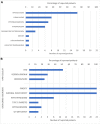Two Cases With an Early Presented Proopiomelanocortin Deficiency-A Long-Term Follow-Up and Systematic Literature Review
- PMID: 34177811
- PMCID: PMC8220084
- DOI: 10.3389/fendo.2021.689387
Two Cases With an Early Presented Proopiomelanocortin Deficiency-A Long-Term Follow-Up and Systematic Literature Review
Abstract
Proopiomelanocortin (POMC) deficiency is an extremely rare inherited autosomal recessive disorder characterized by severe obesity, adrenal insufficiency, skin hypopigmentation, and red hair. It is caused by pathogenic variants in the POMC gene that codes the proopiomelanocortin polypeptide which is cleaved to several peptides; the most notable ones are adrenocorticotropic hormone (ACTH), alpha- and beta-melanocyte-stimulating hormones (α-MSH and β-MSH); the latter two are crucial in melanogenesis and the energy balance by regulating feeding behavior and energy homeostasis through melanocortin receptor 4 (MC4R). The lack of its regulation leads to polyphagia and early onset severe obesity. A novel MC4R agonist, setmelanotide, has shown promising results regarding weight loss in patients with POMC deficiency. A systematic review on previously published clinical and genetic characteristics of patients with POMC deficiency and additional data obtained from two unrelated patients in our care was performed. A 25-year-old male patient, partly previously reported, was remarkable for childhood developed type 1 diabetes (T1D), transient growth hormone deficiency, and delayed puberty. The second case is a girl with an unusual presentation with central hypothyroidism and normal pigmentation of skin and hair. Of all evaluated cases, only 50% of patients had characteristic red hair, fair skin, and eye phenotype. Central hypothyroidism was reported in 36% of patients; furthermore, scarce adolescent data indicate possible growth axis dysbalance and central hypogonadism. T1D was unexpectedly prevalent in POMC deficiency, reported in 14% of patients, which could be an underestimation. POMC deficiency reveals to be a syndrome with several endocrinological abnormalities, some of which may become apparent with time. Apart from timely diagnosis, careful clinical follow-up of patients through childhood and adolescence for possible additional disease manifestations is warranted.
Keywords: POMC deficiency; adrenal insufficiency; obesity; proopiomelanocortin; setmelanotide; systematic review; type 1 diabetes.
Copyright © 2021 Gregoric, Groselj, Bratina, Debeljak, Zerjav Tansek, Suput Omladic, Kovac, Battelino, Kotnik and Avbelj Stefanija.
Conflict of interest statement
The authors declare that the research was conducted in the absence of any commercial or financial relationships that could be construed as a potential conflict of interest.
Figures





Similar articles
-
A novel mutation in the proopiomelanocortin (POMC) gene of a Hispanic child: metformin treatment shows a beneficial impact on the body mass index.J Pediatr Endocrinol Metab. 2018 Jul 26;31(7):815-819. doi: 10.1515/jpem-2017-0467. J Pediatr Endocrinol Metab. 2018. PMID: 29858905
-
Delayed diagnosis of proopiomelanocortin (POMC) deficiency with type 1 diabetes in a 9-year-old girl and her infant sibling.J Pediatr Endocrinol Metab. 2017 Oct 26;30(10):1137-1140. doi: 10.1515/jpem-2017-0064. J Pediatr Endocrinol Metab. 2017. PMID: 28915118
-
Severe early-onset obesity, adrenal insufficiency and red hair pigmentation caused by POMC mutations in humans.Nat Genet. 1998 Jun;19(2):155-7. doi: 10.1038/509. Nat Genet. 1998. PMID: 9620771
-
Proopiomelanocortin deficiency diagnosed in infancy in two boys and a review of the known cases.J Paediatr Child Health. 2021 Apr;57(4):484-490. doi: 10.1111/jpc.15407. Epub 2021 Mar 5. J Paediatr Child Health. 2021. PMID: 33666293 Review.
-
Proopiomelanocortin Deficiency – RETIRED CHAPTER, FOR HISTORICAL REFERENCE ONLY.2013 Dec 12. In: Adam MP, Feldman J, Mirzaa GM, Pagon RA, Wallace SE, Amemiya A, editors. GeneReviews® [Internet]. Seattle (WA): University of Washington, Seattle; 1993–2025. 2013 Dec 12. In: Adam MP, Feldman J, Mirzaa GM, Pagon RA, Wallace SE, Amemiya A, editors. GeneReviews® [Internet]. Seattle (WA): University of Washington, Seattle; 1993–2025. PMID: 24354022 Free Books & Documents. Review.
Cited by
-
Proopiomelanocortin (POMC) and psychodermatology.Skin Health Dis. 2023 Apr 7;3(3):e201. doi: 10.1002/ski2.201. eCollection 2023 Jun. Skin Health Dis. 2023. PMID: 37275429 Free PMC article. Review.
-
Neuroendocrine Effects on the Risk of Metabolic Syndrome in Children.Metabolites. 2023 Jun 29;13(7):810. doi: 10.3390/metabo13070810. Metabolites. 2023. PMID: 37512517 Free PMC article. Review.
-
Advances in Anti-obesity Pharmacotherapy: Current Treatments, Emerging Therapies, and Challenges.Cureus. 2023 Oct 7;15(10):e46623. doi: 10.7759/cureus.46623. eCollection 2023 Oct. Cureus. 2023. PMID: 37937009 Free PMC article. Review.
-
Differentiating monogenic and syndromic obesities from polygenic obesity: Assessment, diagnosis, and management.Obes Pillars. 2024 Apr 22;11:100110. doi: 10.1016/j.obpill.2024.100110. eCollection 2024 Sep. Obes Pillars. 2024. PMID: 38766314 Free PMC article. Review.
-
Serum kisspeptin and proopiomelanocortin in cystic fibrosis: a single study.Sci Rep. 2022 Oct 21;12(1):17669. doi: 10.1038/s41598-022-21851-8. Sci Rep. 2022. PMID: 36271282 Free PMC article.
References
-
- Clément K, van den Akker E, Argente J, Bahm A, Chung WK, Connors H, et al. . Setmelanotide POMC and LEPR Phase 3 Trial Investigators. Efficacy and Safety of Setmelanotide, an MC4R Agonist, in Individuals With Severe Obesity Due to LEPR or POMC Deficiency: Single-Arm, Open-Label, Multicentre, Phase 3 Trials. Lancet Diabetes Endocrinol (2020) 8:960–70. 10.1016/S2213-8587(20)30364-8 - DOI - PubMed
-
- Ranke MB. Growth Hormone Deficiency: Diagnostic Principles and Practice. In: Diagnostics of Endocrine Function in Children and Adolescents, edn 4. Basel: KARGER; (2011). p. ch. 6 pp 102–37, ch. 15 pp 294-309, ch. 18 pp 350-78.
Publication types
MeSH terms
Substances
LinkOut - more resources
Full Text Sources
Other Literature Sources
Medical
Miscellaneous

